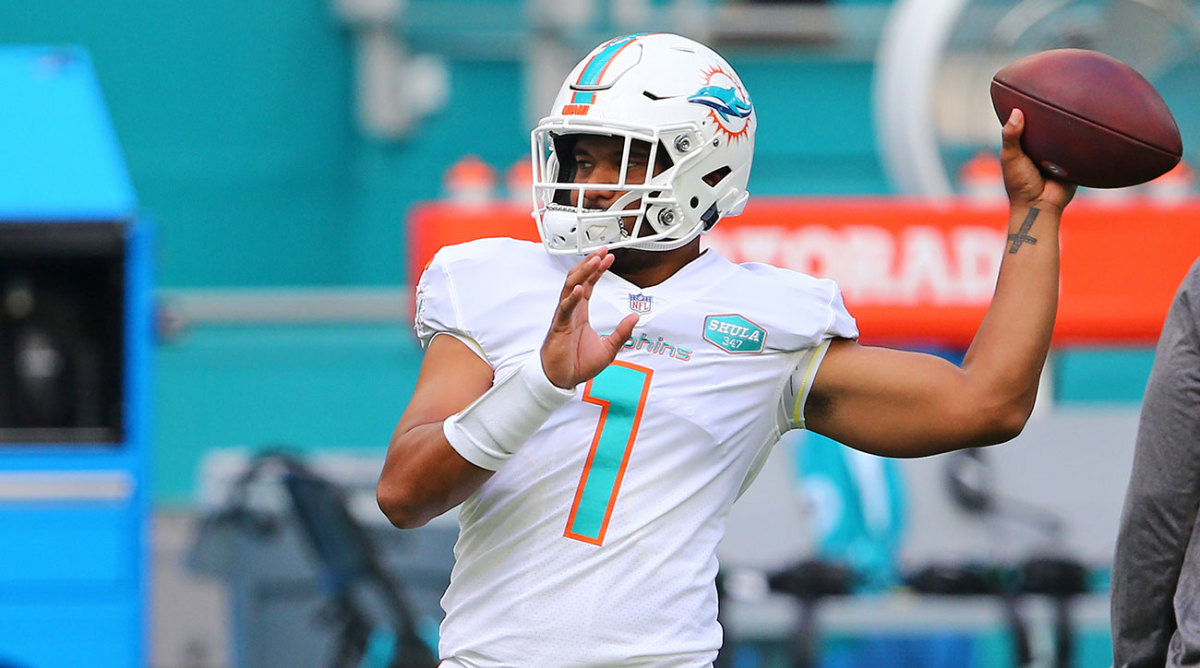The Dolphins Should be Thinking Playoffs With Tua Tagovailoa Taking Over
Amid this calamitous offseason, it was probably difficult enough for other teams to prepare for the Dolphins offensively, even knowing that Ryan Fitzpatrick would pair with his forever muse, offensive coordinator Chan Gailey, and run some of the same concepts he had success with in previous stops with the Bills and the Jets. As many have come to understand, Fitzpatrick’s nuclear volatility cannot be measured on any standardized scientific scale and the result—Fitzpatrick leading the Dolphins to second place in the AFC East with a better points-over-expected-completion-percentage mark than Patrick Mahomes, Tom Brady and Drew Brees—reflected as much.
Still, one might argue that pivoting to Tua Tagovailoa now gives the Dolphins an even larger boon heading into the most critical stretch of their season, a slate of games that could cement them as legitimate contenders for a division title less than a year after they were orchestrating a lead-balloon tanking the likes of which the NFL had not seen in quite some time.
It’s not because there is always an inevitable downside to the Fitzpatrick curve, although some of his former head coaches might caution Brian Flores that an ascent with Fitzpatrick always has an abrupt end. It’s because the Dolphins are essentially rebooting their season with a massive advantage over the Rams, Cardinals and Chargers (their next three opponents)—a shiny, new offense, featuring one of the best quarterbacks college football has seen in the past 10 years.

It would not surprise me, and should not surprise you, if this is the kind of move that lifts Miami to the playoffs. (If you think that is a hot take, check out what they're saying down in Florida already.)
As we saw in limited glimpses against the Jets on Sunday, even a basic rollout from the rookie quarterback forces an adjustment defensively, as players are used to following the flow of a right-handed QB. The plays that do carry over from Miami’s playbook are now flipped, which allows Gailey a chance to play some three-dimensional chess during the bye week and punish defensive coordinators trying to pick up on his tendencies.
More immediately apparent, though, will be the ways in which the offense takes an entirely different course altogether. Think about Colin Kaepernick’s age-25 season in San Francisco, when he was teased throughout the early portions of the season and then inserted for Alex Smith following a concussion. The offense diverted from its path and, by design, unfolded a series of wrinkles that made the 49ers exponentially harder to match up against over the final seven games of the season. San Francisco won five of the next seven games Kaepernick started, with the quarterback putting up more than 1,800 total yards of offense over that span.
If this sounds like we’re placing lofty expectations on Tagovailoa—again, check on the folks down in Miami if you want some real juice—there is always a natural advantage to pivoting during the season to a quarterback of equal or better value. This was true in Cleveland when Baker Mayfield took over for Tyrod Taylor. It was true even for the Giants when Daniel Jones stepped on the field for Eli Manning and, for perhaps the first time in franchise history, allowed the organization to call a zone read handoff where the defense had to respect the quarterback taking off for a run.
At Alabama, Tagovailoa’s expected points added per drop back was 0.43 his sophomore year and 0.49 his junior season, compared to 0.0 and 0.39 for Joe Burrow, respectively, and 0.11 and 0.1 for Justin Herbert. We’ve seen what both of those quarterbacks have added to their NFL franchises over a small sample size this season and there’s a sense, based on his collegiate body of work, that Tagovailoa might be able to do more. He has a better offensive line than either of his rookie counterparts at the moment. He has had the benefit of being eased into professional action with one of the better mentors in football, in Fitzpatrick. And, unlike Burrow or Herbert, there is no developing Rolodex of his tendencies yet being developed, which is next to impossible without the context of what the offense will look like.
While it’s too early to say that Miami has handled all of this masterfully, from the beginning of the fire sale at the start of Flores’s tenure to now, it’s difficult to find a flaw in the team’s master plan. The next step is watching their quarterback of the future legitimize all of the other moves that brought them to this ideal position.
More from All Dolphins:
- Column: Tua time has arrived
- Report: Tua Tagovailoa taking over as starter
- News: Tua 'Excited' after NFL debut
